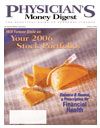Publication
Article
Physician's Money Digest
Don't Bail Out of the Stock Market Yet
Author(s):
Many incidents overthe past severalyears have spurredeconomists to predictan economiccatastrophe. The US dollar has weakenedvs the Euro, our deficit grew to arecord-breaking $433 billion in 2003and $412 billion in 2004, militaryspending for Iraq and Afghanistan hasincreased, destructive hurricanes havethrashed the country, and oil reached$72 a barrel in October 2005. Becausegas was $3 a gallon, economistsfeared that consumers would not beable to spend money at Wal-Mart andfuel the economy.
Yet 1 month later in November2005, Wal-Mart had only reduced itsearnings by one penny. Despite all ofthe foreboding predictions, US companiesare making money. Reportedearnings posted a 12% gain duringthe first quarter, resulting in its highestever dollar value in the S&P 500'shistory. How do we explain this inexplicableeconomic growth?
Economics of Spending
Let's look at the one major factorthat is driving 70% of our economy—consumer spending. The baby boomers,the biggest spenders of all, have verypredictable spending patterns. The USBureau of Labor Statistics conducts anongoing Consumer Expenditure Surveythat measures how much people spendon over 1000 different items per year,down to the penny. This data provides avery clear picture of who is spendingand on what. Likewise, it shows how, invery predictable ways and at predictableages, consumers stop spending.
For instance, we know an average41-year-old female will spend moremoney on potato chips than at anyother time in her life. How could weknow this? On average, this femalemarried at age 25 and had her firstchild at age 271/2. Fourteen yearslater, that same child is at their peakcalorie intake and is eating her out ofhouse and home. It's not mom eatingthose potato chips, but teenagers.Corporate America bases much oftheir product marketing decisions onthe Consumer Expenditure Survey.
Predicting Patterns
What does US consumer spendingmean to you as an investor? If youknow exactly when populations enterthe workforce, when changes in thatworkforce take place, when large agegroups buy houses, cars, travel, andspend at their peak, you can also predictother areas of spending with ahigh percentage of accuracy. Sincespending patterns relate to companyearnings, and the price of publiclyheld stock companies reflects thoseearnings, observing spending patternsgives you a glimpse into the future ofour economy.
You don't have to be an economistor stockbroker to predict that thenext big spending spree in the UnitedStates will occur in the area of healthcare. As the baby boom populationages and slows their spending, wemight be headed for financial uncertainty,but that's still 6 to 8 yearsaway. The good news is we have asubstantial growth curve to benefitfrom before then.
Jim Lunney is a certified financial and estate
planner located in Littleton, Colo. He welcomes
questions or comments at 800-800-6364, james.lunney@lpl.com, or visit www.lpl.com/james.lunney. Securities offered through Linsco/Private Ledger member SIPC.
